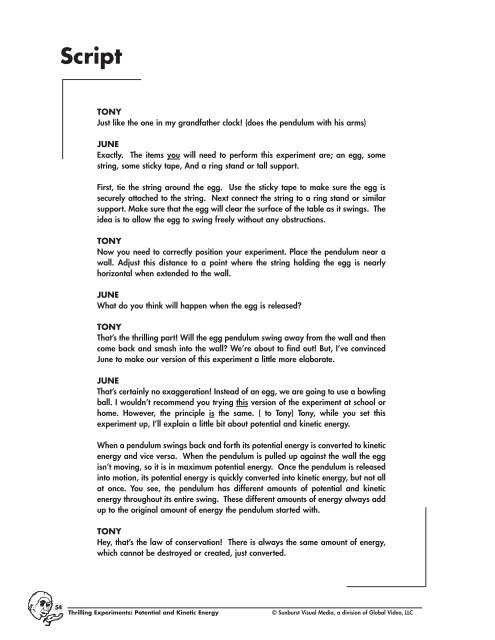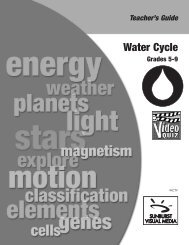Thrilling Experiments: Potential and Kinetic Energy
Thrilling Experiments: Potential and Kinetic Energy
Thrilling Experiments: Potential and Kinetic Energy
You also want an ePaper? Increase the reach of your titles
YUMPU automatically turns print PDFs into web optimized ePapers that Google loves.
Script<br />
54<br />
TONY<br />
Just like the one in my gr<strong>and</strong>father clock! (does the pendulum with his arms)<br />
JUNE<br />
Exactly. The items you will need to perform this experiment are; an egg, some<br />
string, some sticky tape, And a ring st<strong>and</strong> or tall support.<br />
First, tie the string around the egg. Use the sticky tape to make sure the egg is<br />
securely attached to the string. Next connect the string to a ring st<strong>and</strong> or similar<br />
support. Make sure that the egg will clear the surface of the table as it swings. The<br />
idea is to allow the egg to swing freely without any obstructions.<br />
TONY<br />
Now you need to correctly position your experiment. Place the pendulum near a<br />
wall. Adjust this distance to a point where the string holding the egg is nearly<br />
horizontal when extended to the wall.<br />
JUNE<br />
What do you think will happen when the egg is released?<br />
TONY<br />
That’s the thrilling part! Will the egg pendulum swing away from the wall <strong>and</strong> then<br />
come back <strong>and</strong> smash into the wall? We’re about to find out! But, I’ve convinced<br />
June to make our version of this experiment a little more elaborate.<br />
JUNE<br />
That’s certainly no exaggeration! Instead of an egg, we are going to use a bowling<br />
ball. I wouldn’t recommend you trying this version of the experiment at school or<br />
home. However, the principle is the same. ( to Tony) Tony, while you set this<br />
experiment up, I’ll explain a little bit about potential <strong>and</strong> kinetic energy.<br />
When a pendulum swings back <strong>and</strong> forth its potential energy is converted to kinetic<br />
energy <strong>and</strong> vice versa. When the pendulum is pulled up against the wall the egg<br />
isn’t moving, so it is in maximum potential energy. Once the pendulum is released<br />
into motion, its potential energy is quickly converted into kinetic energy, but not all<br />
at once. You see, the pendulum has different amounts of potential <strong>and</strong> kinetic<br />
energy throughout its entire swing. These different amounts of energy always add<br />
up to the original amount of energy the pendulum started with.<br />
TONY<br />
Hey, that’s the law of conservation! There is always the same amount of energy,<br />
which cannot be destroyed or created, just converted.<br />
<strong>Thrilling</strong> <strong>Experiments</strong>: <strong>Potential</strong> <strong>and</strong> <strong>Kinetic</strong> <strong>Energy</strong> © Sunburst Visual Media, a division of Global Video, LLC











